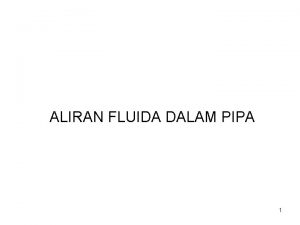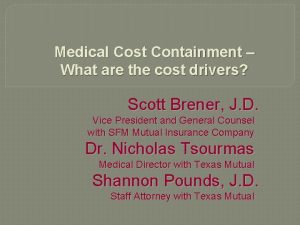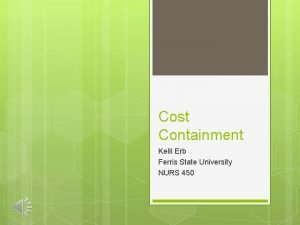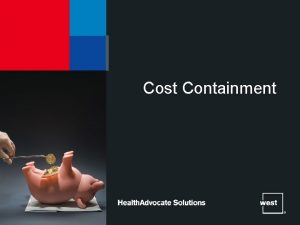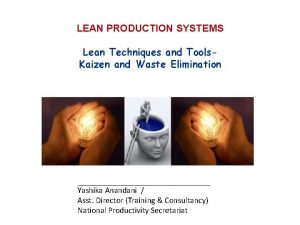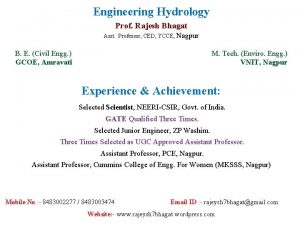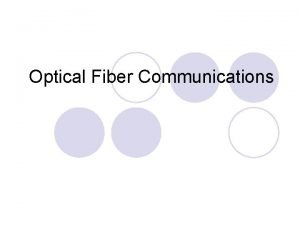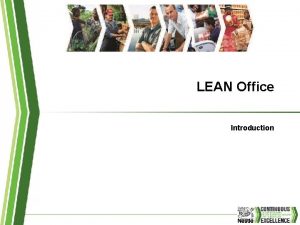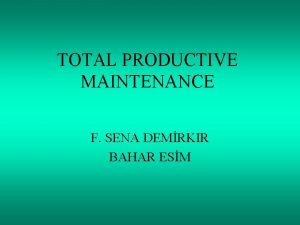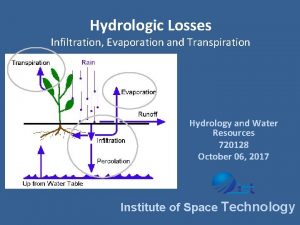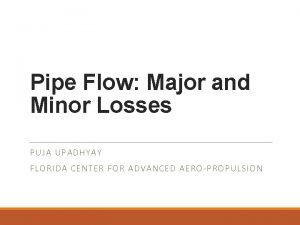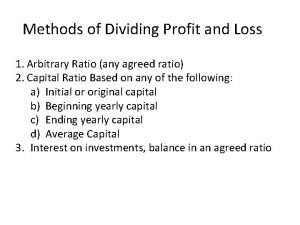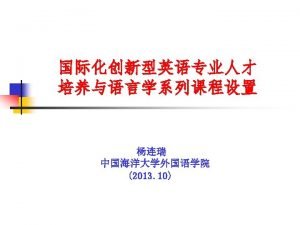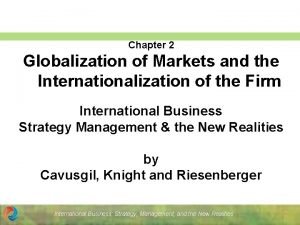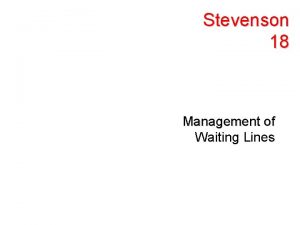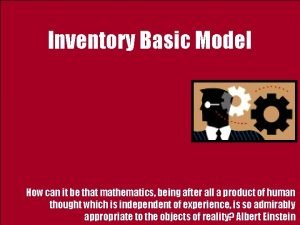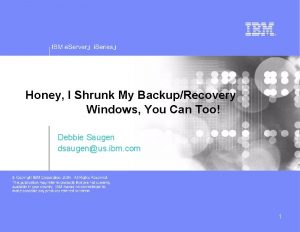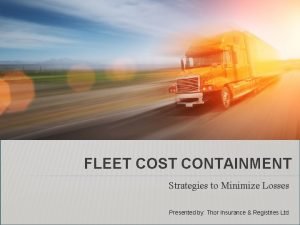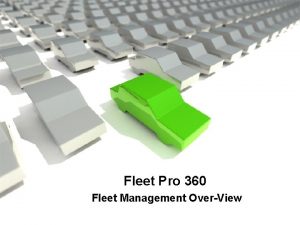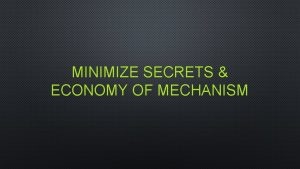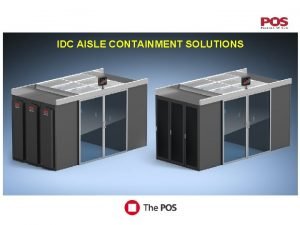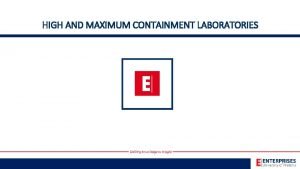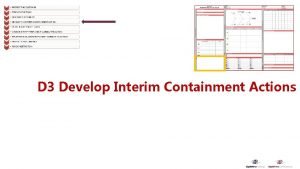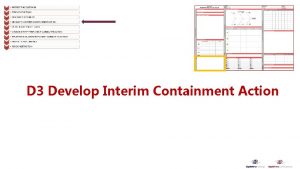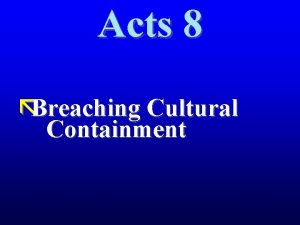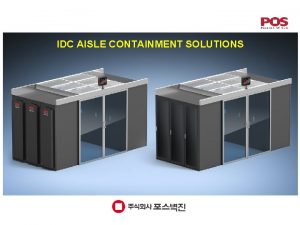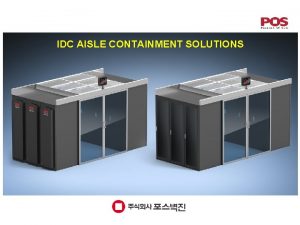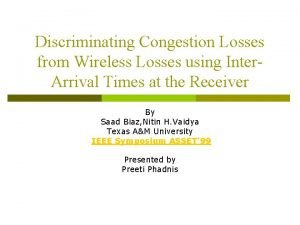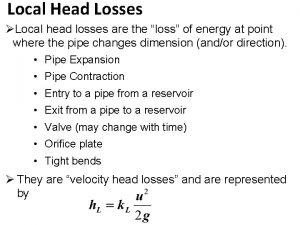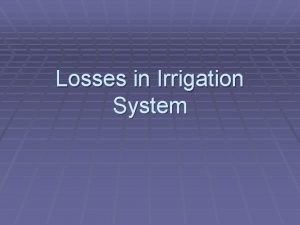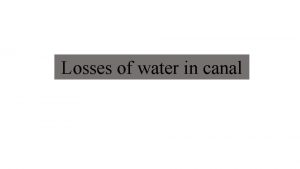FLEET COST CONTAINMENT Strategies to Minimize Losses Presented


























- Slides: 26

FLEET COST CONTAINMENT Strategies to Minimize Losses Presented by: Awesome Agency

THE COST OF MOTOR VEHICLE ACCIDENTS Ò Transportation incidents were the leading cause of work-related fatalities in 2018 – nearly 40% of all occupational fatalities. Ò Of all transportation fatalities: É 57% occurred on roadways É 17% involved pedestrians Source: Bureau of Labor Statistics

THE COST OF MOTOR VEHICLE ACCIDENTS DID YOU KNOW…? Transportation incidents caused more on-the-job fatalities in 2018 than falls and injuries as a result of contact with objects and equipment combined Source: BLS

AGENDA Learn how to: ü Establish a formal fleet safety policy ü Conduct pre-accident planning education ü Provide initial and ongoing driver training ü Perform regular vehicle maintenance ü Use one insurance carrier to streamline claims handling procedures

LOSS CONTROL STRATEGIES 1. Establish a written Fleet Safety Policy should outline Angie Long requirements, procedures and standards for: • Recruitment • Alcohol and Controlled Substances Testing • Job Duties • Training • Scheduled and Incidental Maintenance • Accident Investigation • Personal Use of Company Vehicles

LOSS CONTROL STRATEGIES ÒOther important aspects of a Fleet Safety Policy: É Actively review and update policy annually É Require all employees to read and sign off on policy You, as management, must show your commitment to the policy by actively enforcing its provisions and updating them as necessary. Lead by example; employees will only take fleet safety seriously and follow the policy if you do the same.

LOSS CONTROL STRATEGIES 2. Establish pre-employment screening and new hire driving requirements ÒConsider: É É Past driving experience Past employer references Types of vehicles driven Past motor vehicle violations (both on and off the job) ÒUniform standards and a comprehensive application will allow you to expose irresponsible, hazardous drivers

LOSS CONTROL STRATEGIES 3. Enact alcohol and controlled substance screening policies ÒAlcohol É É and controlled substance tests should be required: Pre-employment Post-accident If reasonable suspicion arises At random ÒDrug screening policies could lower your costs

LOSS CONTROL STRATEGIES Ò Effective random/reasonable suspicion alcohol and controlled substance screening policies will: É É Be conducted as soon as a supervisor observes behavior or appearance characteristic of substance abuse Be collected on a random, unannounced basis Be conducted before an individual returns to work following an alcohol policy violation Contain explicit consequences for refusal or failure to test, up to and including termination

LOSS CONTROL STRATEGIES Ò Effective post-accident alcohol and controlled substance screening policies will: É Go into effect when a driver receives a moving traffic violation OR whenever there is a fatality É Require a strict timeline (example: test must be taken within two hours of accident) É Contain explicit consequences for refusal or failure to test post-accident, up to and including termination

LOSS CONTROL STRATEGIES 4. Determine driver acceptability criteria Ò Ò Ò All members of management should agree on prospective driver criteria Consistently and carefully choosing good drivers will allow you to save in accident costs down the road FMCSA reports that it is riskier to hire drivers who are: É É É Younger (18 -25 years old) Less experienced Have a documented sleep disorder Impulsive in nature Generally aggressive or angry toward others

LOSS CONTROL STRATEGIES 5. Develop a cell phone/handheld device policy Ò Most states now have cell phone use laws of some kind in place Ò Studies show using a cell phone while driving is just as dangerous – if not more so – as driving under the influence Ò Consider prohibiting cell phone use behind the wheel while on the job even if your state does not do so Ò Carefully outline what constitutes proper and improper cell phone use

LOSS CONTROL STRATEGIES Ò An effective cellphone/handheld device use policy will: É Define what constitutes a cellphone or handheld device É Be specific and address all possibilities, including handset vs. headset use, text messaging, surfing the Web, GPS use, etc. É Briefly address other driving distractions, including, but not limited to, touching stereo dials, eating, drinking or talking to passengers

LOSS CONTROL STRATEGIES 6. Review policies with new employees at orientation and periodically with active employees É É É Offer materials in workers’ native languages Consider annually re-training active employees Re-train employees after they are involved in an accident Develop a system for keeping track of when employees received their most recent training session Hold mandatory monthly safety meetings covering hot topics Provide employees with constant policy reminders to keep safety and loss control top-of-mind

PRE-ACCIDENT STRATEGIES Ò Provide pre-accident training, highlighting: É É É Correct use of provided accident kit Proper accident procedures Proper recordkeeping procedures What to do in case of medical emergency What to do in case of HAZMAT emergency

PRE-ACCIDENT STRATEGIES Ò Supplying drivers with an accident kit in their glove box that includes: É É É Ò Emergency contact numbers Accident report form Blank paper Pen Disposable camera This will help document the events of an accident to ensure there is accurate, reliable information when filing a claim

PRE-ACCIDENT STRATEGIES Ò If the vehicle contains hazardous materials, also include these items in the accident kit: É É É Duct tape Plastic sheeting Scissors Ð These items could be crucial in an accident that involves a HAZMAT unit response

PRE-ACCIDENT STRATEGIES Ò Educate drivers on accident procedures: É Turn on hazards or otherwise warn other drivers that an accident has occurred to avoid further mishaps É Immediately contact police É Only get out of the vehicle if it is safe to do so É If it is not safe to exit, stay in vehicle with seat belt on É Do not admit fault É Only discuss details of the accident with the police É Report accident to employer immediately

PRE-ACCIDENT STRATEGIES Ò Educate drivers on recordkeeping procedures: É É Record incident details on Accident Report Form Include details on other people involved any witnesses Note names of all passengers involved Take photos of both vehicles involved in the accident

PRE-ACCIDENT STRATEGIES Ò Educate drivers on medical emergency procedures: É É Seek medical attention as soon as possible if anyone on the scene is injured Give reasonable assistance until professional help arrives to injured parties if you are fit and able Do not administer first aid unless trained, qualified and comfortable enough to do so If unable to drive, contact dispatcher and coordinate arrangements for pick up of cargo

PRE-ACCIDENT STRATEGIES Ò Educate drivers on HAZMAT emergency procedures: É É Contact dispatcher immediately Coordinate a HAZMAT unit as soon as possible Evacuate vehicle if safe to do so If you must remain in vehicle, shut windows, close vents and turn off air conditioner and heater

VEHICLE INSPECTION & MAINTENANCE Ò Keep detailed records of vehicle maintenance and inspections, including dates of service Ò Require drivers to complete – and sign off on – a basic vehicle maintenance checklist daily Ò Follow up promptly on any problems/issues drivers note in daily inspection log

VEHICLE INSPECTION & MAINTENANCE Ò Critical daily maintenance items include: É É É É Ò Brakes Steering Windows Tires Lights Windshield Wipers Suspension Mirrors Full-vehicle preventative maintenance should be conducted once a year, or as needed, by a professional

CARRIER CONSIDERATIONS Ò Consider using one insurance carrier and choose your broker based on experience in your industry. Reduces cost and administrative headaches Ò Streamlines claims management process Ò

FLEET COST CONTROL STRATEGY SUMMARY Ò Establish a formal fleet safety policy Ò Determine new driver acceptability criteria Ò Establish pre-employment screening requirements Ò Develop a cell phone/handheld device use policy Ò Review all policies/procedures with new employees and at least annually with active employees Ò Provide pre-accident training for all employees Ò Require regular vehicle inspection and maintenance Ò Use one insurance carrier to streamline claims process

OUR EXPERTISE Awesome Agency We have the loss control experience and resources to help you manage your fleet program, promote a safety -minded culture and reduce the financial burden of vehicle-related accidents. Contact Jason Rigby, CRM For more information on how we can help your 1 -800 -GOT-JUNK? Franchise: jasonrigby@libertyins. com / Office: 412 -5714 Ext. 255 / Mobile: 412 -610 -2303
 Contoh soal pipa bercabang
Contoh soal pipa bercabang Reckless containment theory
Reckless containment theory Dr nicholas tsourmas
Dr nicholas tsourmas Cost containment definition
Cost containment definition Cost containment in nursing
Cost containment in nursing Accent cost containment solutions
Accent cost containment solutions Process losses in teams
Process losses in teams Nonrecaptured section 1231 losses
Nonrecaptured section 1231 losses Set off and carry forward of losses notes
Set off and carry forward of losses notes Six big losses in lean manufacturing
Six big losses in lean manufacturing Disenfranchised grief losses
Disenfranchised grief losses Khosla formula for runoff
Khosla formula for runoff Optical power loss
Optical power loss Change definition
Change definition Otdr
Otdr Tpm tqm
Tpm tqm Vinput leah
Vinput leah Hydrologic losses
Hydrologic losses Critical reynolds number
Critical reynolds number German territorial losses
German territorial losses Arbitrary ratio meaning
Arbitrary ratio meaning Minimize perceptual mismatches
Minimize perceptual mismatches Minimize dfa
Minimize dfa Globalization of market
Globalization of market The goal of waiting line management is to minimize
The goal of waiting line management is to minimize Most inventory models attempt to minimize
Most inventory models attempt to minimize How to minimize a window
How to minimize a window
